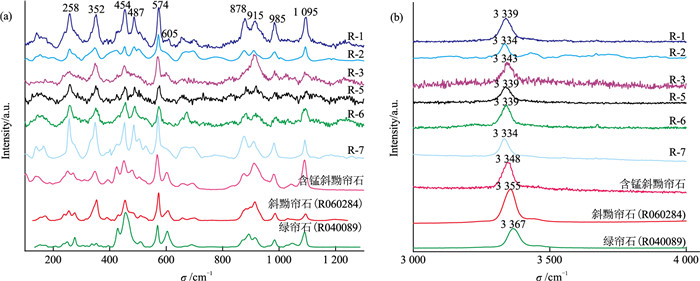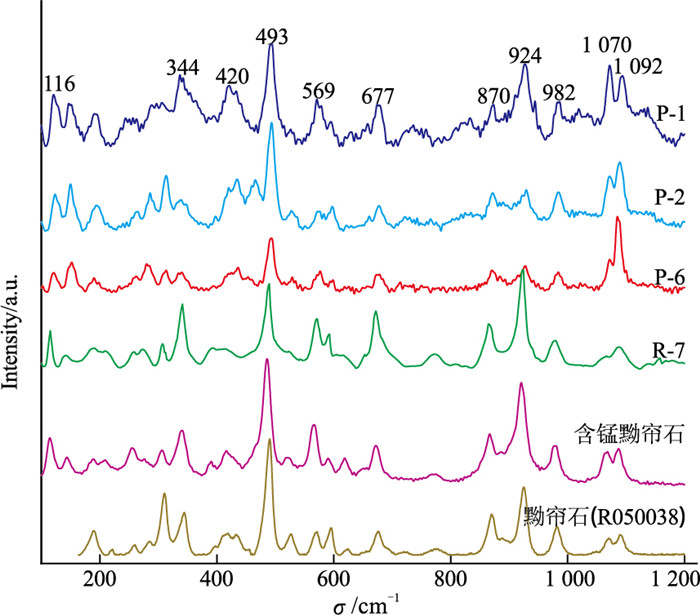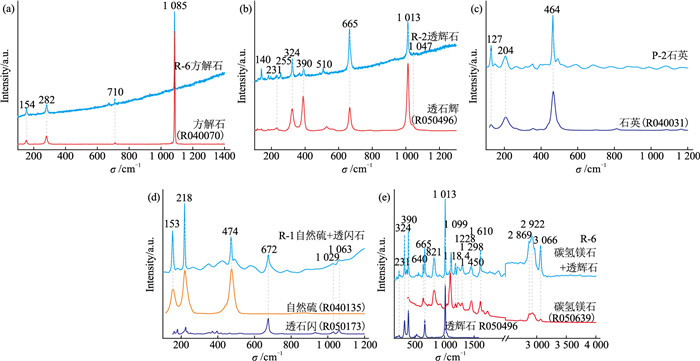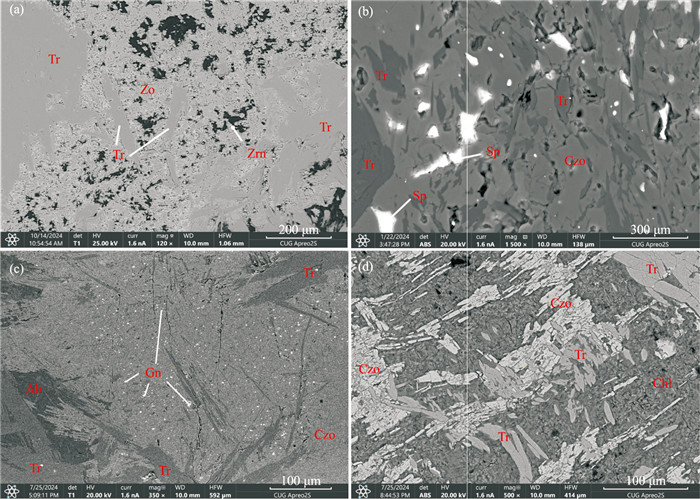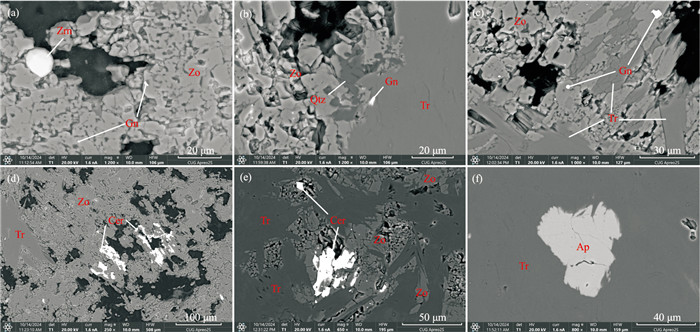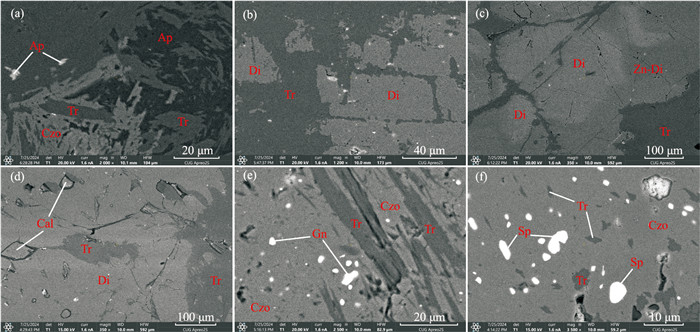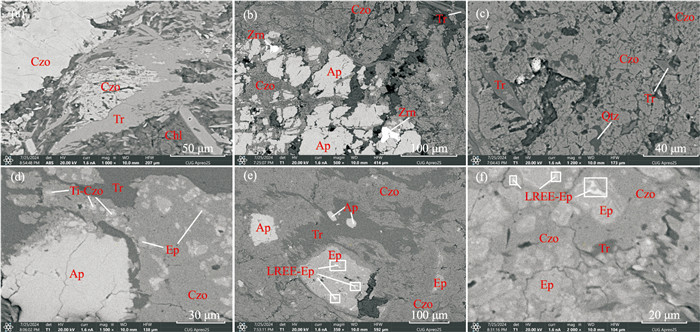Gemmological and Mineralogical Characteristics of Nephrite Containing Pink or Red Minerals
-
摘要:
近期,在珠宝市场上出现了含粉色或红色矿物的和田玉,其颜色商业上常称为“樱花粉”和“胭脂红”。前人认为粉色是由于含Mn绿帘石或黝帘石所致,目前未见含红色矿物和田玉的报道。本研究采用常规宝石学仪器、拉曼光谱仪、扫描电子显微镜、紫外-可见光谱仪和激光剥蚀电感耦合等离子体质谱仪对含粉色或红色矿物和田玉的矿物组成及颜色成因进行了探讨。结果表明,含粉色或红色矿物和田玉样品的致色矿物分别为含Mn3+的黝帘石和含Mn3+的斜黝帘石,其颜色均主要由在M3位Mn3+的d-d跃迁导致。经拉曼光谱测试,次要矿物碳氢镁石和自然硫首次在含红色矿物和田玉样品中发现。
Abstract:Recently, nephrite containing pink or red minerals has appeared on the market, the former is called "Cherry Blossom Pink", and the latter is called "Carmine". For nephrite containing pink minerals, some researchers suggested that the pink colour may be caused by Mn-bearing epidote, and some agreed that it might be caused by Mn-bearing zoisite. At present, no report can be found on nephrite containing red minerals. In this study, conventional gemmological test instruments, Raman spectroscopy, scanning electron microscope, UV-Vis spectroscopy and laser ablation inductively coupled plasma mass spectroscopy (LA-ICP-MS) were used to investigate the mineral components and colour origin of these two kinds of nephrite. The results showed that the colouring minerals in these kinds of nephrite samples are Mn3+-bearing zoisite(pink) and Mn3+-bearing clinozoisite(red), respectively, and their colours were mainly caused by the d-d transition of Mn3+ at the M3 site. By Raman spectroscopy, two minor minerals, nesquehonite and native sulphur, were found in the nephrite containing red minerals for the first time.
-
Keywords:
- nephrite /
- zoisite /
- clinozoisite /
- colour origin /
- mineral component
-
近期,一种含粉色或红色矿物的和田玉在市场上出现,商家对含粉色矿物者的颜色描述为“樱花粉”,对含有偏红色矿物者的颜色描述为“胭脂红”。随着这种含粉色或红色矿物和田玉价格的上升,市场上存在不法商家将蔷薇辉石、粉色佘太翠(商业名称“桃花酿”)、粉色独山玉及和田玉脉周围的粉色围岩等矿石冒充这种和田玉进行销售。
目前,关于含粉色矿物和田玉的致色机理的研究尚未形成统一认识。王蔚宁等[1]对青海、韩国春川和俄罗斯贝加尔湖地区含粉色矿物的青色和田玉样品进行研究,推断粉色可能是含Mn2+的黝帘石混入造成;唐建磊等[2]对新疆且末白色软玉伴生粉色矿物进行研究,推断粉色是含Mn的绿帘石造成。前人在研究和田玉矿区地质构造和共生矿物组合时,对新疆若羌县扶果岭及且末县天泰和金山矿区和田玉矿脉边上的粉色围岩与和田玉山料的关系进行了研究,认为粉色矿物可能与同矿区的粉色围岩或脉石(即黝帘石化花岗岩)有关[3],粉红色黝帘石化花岗岩穿插糖玉(金山2号矿区)[4-5]、青玉(若羌县扶果岭)[6]和青白玉(天泰矿)[4,7-8]导致和田玉中含有粉色矿物。在对粉色黝帘石的颜色成因研究中,张旖旎[9]认为独山玉中的粉色黝帘石的颜色与Mn3+的晶体场允许跃迁有关。此外,目前未见对含红色矿物的和田玉进行研究的报道。
在含粉色矿物和田玉的颜色成因问题探讨中,绿帘石为绿帘石族矿物,黝帘石同绿帘石族矿物中的斜黝帘石互为同质多象变体,但不属于绿帘石族。绿帘石族的理想化学式为(A12+A22+)(M13+M23+M33+)O[Si2O7][SiO4](OH)。A位通常以Ca2+为主,M位主要以Al3+为主,M3位点的Al3+可被Fe3+、Mn3+替代[10]。斜黝帘石和绿帘石的完全类质同象系列表现为M3位点Fe3+和Al3+的相互取代[11]。M位Fe和Mn对Al的类质同象替代会导致晶体结构发生变化,在拉曼光谱上产生细微差别[12-14];黝帘石为斜方晶系,其拉曼光谱和单斜晶系的斜黝帘石存在较大区别[14]。
为了探究含粉色或红色矿物和田玉的致色矿物,笔者收集了一些含粉色或红色矿物的和田玉及相关样品,在前人研究基础上利用常规宝石学测试、拉曼光谱仪、扫描电子显微镜(SEM)、紫外-可见分光光度计(UV-Vis)以及激光剥蚀电感耦合等离子体质谱仪(LA-ICP-MS)等手段来探究其矿物组成以及颜色成因,并对相似品种进行区分。
1. 样品及测试方法
1.1 样品情况
本文收集14件基底为白色或青色的含粉色或红色矿物的和田玉及相关样品(图 1a)。按照颜色分为含红色矿物组(R组)和含粉色矿物组(P组):其中,样品R-1到R-6为含红色矿物的和田玉,样品R-7为含红色和粉色的和田玉;样品P-1到P-5为含粉色矿物和田玉,样品P-6和P-7整体为粉色。由于价格昂贵,仅将具有典型特征的样品R-3、R-5、R-6及P-3磨成标准偏光薄片。3个相似品种(图 1b)分别为:含石英的蔷薇辉石样品S-1、“桃花酿”佘太翠手镯样品S-2、粉色独山玉圆珠样品S-3;对比用矿物标本(图 1c)分别为经拉曼光谱、LA-ICP-MS和紫外-可见吸收光谱确认的紫色含锰的透闪石(hexagonite)和经拉曼光谱和紫外-可见吸收光谱确认红色部分为含锰的斜黝帘石(clinothulite)以及粉色部分为含锰的黝帘石(thulite)。
1.2 测试方法
常规宝石学测试,包括折射率和相对密度测试,折射率测试采用点测法,相对密度测试采用静水称重法,每个样品均测三次,取平均值。
拉曼光谱测试使用Bruker公司Senterra型激光拉曼光谱仪,测试条件:激发光源波长532 nm, 光栅600 gr/mm,扫描范围100~4 000 cm-1,扫描时间20 s,叠加次数2次。
扫描电子显微镜-能谱测试(SEM-EDS)使用配备Oxford Ultim Max 100能量色散X射线光谱仪(EDS)系统的Thermo Scientific Apreo 2S扫描电子显微镜(SEM)对样品进行形貌观察和成分分析。测试前对样品进行喷碳处理,二次电子形貌像和背散射电子成分衬度像分别使用5 kV,0.4 nA和20 kV,1.6 nA进行测试。
紫外-可见吸收光谱分析使用Skyray GEM-UV 100紫外-可见光谱仪测量,该紫外-可见光谱仪装有全反射积分球。测试采用反射法, 测试条件:积分时间110 ms,测试4次,范围为220~1 000 nm。
激光剥蚀电感耦合等离子体质谱测试(LA-ICP-MS)采用Elemental Scientific Lasers NWR213和Analytikjena PlasmaQuant MS仪器,联合相干公司213 nm准分子激光剥蚀系统完成。测试条件:激光剥蚀束斑40 nm,剥蚀频率4 Hz,能量密度3.3 J/cm2。元素含量分析采用多外标(NIST610和NIST612)结合100%归一化校正策略完成。
以上测试均在中国地质大学(武汉)珠宝学院完成。
2. 结果与分析
2.1 基本特征
本文样品常规宝石学特征如表 1所示,样品R-1~R-7及P-1~P-7基底颜色为白色或青色,油脂光泽,半透明;静水称重法测得样品P-6和P-7相对密度分别为2.73和2.69,其他样品相对密度为2.97~3.07;粉色或红色矿物集中处测得折射率约为1.66,基底折射率为1.61~1.63。相似品种中含石英的蔷薇辉石样品S-1因石英含量较高,测得折射率为1.55,相对密度为2.82,接近石英;佘太翠手镯样品S-2的折射率为1.53,接近石英,相对密度因样品过大未测试;粉色独山玉圆珠样品S-3基底的折射率为1.56,相对密度为3.04。在长波(365 nm)和短波(254 nm)紫外荧光灯下以上样品均显示惰性。
表 1 含粉色或红色矿物和田玉和相关样品及相似品种样品的常规宝石学特征Table 1. Conventional gemmological characteristics of nephrite samples containing pink or red minerals, related material samples and similar material samples样品编号 外观特征 相对密度 折射率(点测) R-1 基底白色,有红色点状矿物,白色包裹体 2.98 1.62 R-2 基底白色,有红色点状矿物,白色包裹体 3.01 1.61 R-3 基底青色,有红色点状矿物,白色包裹体 3.05 1.61/1.66 R-4 基底白色,有红色点状矿物,白色包裹体 3.03 1.61 R-5 基底白色,有红色点状矿物,白色和黑色包裹体 3.00 1.61/1.66 R-6 基底白色,有粉红色点状矿物,白色团状矿物 2.98 1.61 R-7 基底白色,有粉色及红色点状矿物 2.98 1.62 P-1 基底白色,有粉色点状矿物,白色团状矿物 - 1.63 P-2 基底白色,有粉色花瓣状团块状包体 3.00 1.61/1.66 P-3 基底白色,有粉色脉状矿物 2.97 1.61 P-4 基底青色,有粉色团块状矿物 2.97 1.63 P-5 基底白色,有粉色矿物呈现点、脉状 3.07 1.61 P-6 粉色,有粉色团块状矿物,含白色矿物 2.73 1.63 P-7 粉色,有粉色团块状矿物,含白色矿物 2.69 1.63 S-1 基底白色,有粉色颗粒状矿物 2.82 1.55 S-2 基底白色,有粉色点状矿物,含白色矿物 - 1.53 S-3 粉色和白色混合,有粉色团块状矿物 3.04 1.56 注:“-”为样品尺寸过大未能测相对密度 2.2 激光拉曼光谱分析
选取样品R-1~R-3、R-5~R-6,P-1、P-2、P-5以及相似品种粉色佘太翠,对其红色及粉色矿物区域进行拉曼光谱测试。
2.2.1 和田玉中粉色或红色区域的主要矿物
和田玉中的粉色或红色区域可测得透闪石的拉曼峰,同RRUFF数据库编号R050173的透闪石相近。含红色矿物区域的拉曼光谱(图 2)显示,258、352、454、487、574、605、878、915、985、1 095 cm-1和3 339 cm-1附近存在散射峰,在100~1 300 cm-1内同斜黝帘石(RRUFF数据库编号R060284)及绿帘石(RRUFF数据库编号R040089)的拉曼光谱相似,但在3 000~4 000 cm-1范围内的羟基振动导致的散射峰[15-16]更接近斜黝帘石。拉曼位移反映斜黝帘石-绿帘石类质同象系列Fe3+含量的研究发现,斜黝帘石和绿帘石主要通过100~1 300 cm-1范围内约570 cm-1处的主峰和3 000~4 000 cm-1范围内羟基峰的拉曼位移特征区分[12-14],570 cm-1附近和[Si2O7]6-相关的散射峰的拉曼位移受偏振影响较小,其位置与Fe含量有显著相关性[12],即随着Fe含量的增加而左移[12-14];3 200~3 600 cm-1范围内羟基伸缩振动导致的散射峰会随Fe含量的增加右移[13]。从本文测试结果看,570 cm-1附近的散射峰主要位于574 cm-1处,羟基伸缩振动的散射峰主要集中在3 339~3 348 cm-1范围,推测样品红色部分斜黝帘石中Fe含量比斜黝帘石的Fe含量低。为验证猜想,红色含锰的斜黝帘石矿物标本的拉曼光谱(图 2a,粉色谱线)与和田玉中红色矿物相似,证明样品中的红色矿物为斜黝帘石,并排除绿帘石的可能。
含粉色矿物组样品的拉曼光谱(图 3)同黝帘石(RRUFF数据库编号R050038)及粉色含锰的黝帘石矿物标本基本一致,其特征峰位于约493、677、870、1 070 cm-1及1 092 cm-1处[17],表明和田玉样品中的粉色矿物为黝帘石。
2.2.2 和田玉中粉色或红色区域的次要矿物
和田玉中的次要矿物具有一定的产地判别意义。本文中样品次要矿物的拉曼光谱显示大部分样品含有方解石(图 4a)和透辉石(图 4b)。样品P-2黝帘石颗粒间存在石英(图 4c),在样品R-1中发现自然硫和透闪石的混合光谱(图 4d)。在样品R-6中发现碳氢镁石的拉曼光谱(图 4e),与碳氢镁石(RRUFF数据库编号R050639)的拉曼光谱一致,1 100 cm-1附近的散射峰为碳氢镁石的特征峰,与Skliros等[18]测得合成碳氢镁石相同,其中,1 450、2 869、2 922、3 066 cm-1处的特征峰归属于-CH3不对称弯曲振动、-CH3伸缩振动、-CH2伸缩振动和C-H伸缩振动所致[19-21],表明样品中包含了有机分子,有机分子可能存在于晶体结构的间隙中[22]。
2.2.3 粉色佘太翠的矿物组成
相似品种中含石英的粉白色蔷薇辉石、粉色独山玉及和田玉脉周围的粉色围岩的矿物组成已经被前人测试并获得[3, 9, 23],但商业称为“桃花酿”或“粉黛”的佘太翠的矿物组成尚未被报道。经过本文拉曼光谱测试发现,粉色矿物为黝帘石,白色矿物为钠长石,透明矿物为石英(图 5)。
2.3 扫描电子显微镜分析
扫描电子显微镜测试结果(图 6)表明,在粉色或红色区域,黝帘石或斜黝帘石为主矿物相,表现为纤维状透闪石交代粒状的黝帘石/斜黝帘石,透闪石分布更加紧密,黝帘石/斜黝帘石颗粒之间存在较为明显间隙。
样品中黝帘石、斜黝帘石和绿帘石的EDS测试结果(表 2)显示,斜黝帘石中Fe占比较黝帘石高。在Fe含量低于0.75 pfu时,Fe仅以Fe3+占据M3位点[24],因此,样品M位的Fe占比可用XFe(Fe3+和ΣM3+的原子数之比)表示。XFe也可以用于区分斜黝帘石和绿帘石,从理想化学式上,斜黝帘石中M3位点Al占据优势,XFe小于0.17;绿帘石中M3位点Fe占据优势,当Fe含量高于0.75 pfu时,即使存在Fe2+,XFe也大于0.17 [24]。因此通过计算XFe可知,含红色矿物和田玉样品R-3中存在斜黝帘石和绿帘石,样品R-5和R-6中存在斜黝帘石。
表 2 和田玉样品中黝帘石、斜黝帘石、绿帘石的EDS测试结果Table 2. EDS results of zoisite, clinozoisite and epidote in the analyzed nephrite samplesat/% 样品编号 Mg Al Si Ca Fe Mn Ti LREE XFe P-3 Zo - 14.61 13.83 9.89 - - - - 0 R-6 Czo - 13.47 14.71 9.82 1.27 - - - 0.09 R-5 Czo 0.24 14.27 14.75 9.50 0.29 - - - 0.02 R-3 Ti-Czo - 8.88 13.62 11.12 0.82 - 4.27 - 0.06 R-3 Mn-Czo 0.26 13.37 14.64 9.82 1.16 0.09 - - 0.08 R-3 LREE-Czo 0.26 12.43 15.01 9.51 1.89 - - 0.22 0.13 R-3 Ep - 10.29 14.90 10.06 4.73 - - - 0.31 R-3 Ep - 11.17 14.81 10.06 3.68 0.09 - - 0.25 R-3 LREE-Ep 0.39 11.60 14.89 8.21 2.85 - - 1.41 0.20 注:“-”为低于检出限,样品编号中Zo为黝帘石; Czo为斜黝帘石; Ti-Czo为含Ti的斜黝帘石; Mn-Czo为含Mn的斜黝帘石; LREE-Czo为含轻稀土的斜黝帘石; Ep为绿帘石; LREE-Ep为含轻稀土的绿帘石 2.3.1 含粉色矿物和田玉的物相测试
手标本P-3特征为粉色矿物在白色和田玉中呈脉状分布。在粉色脉状区域,黝帘石/斜黝帘石颗粒间有锆石(图 7a)、石英(图 7b)、自形程度较好的方铅矿(图 7c)及边缘模糊的白铅矿(图 7d和图 7e)、被透闪石交代的磷灰石(图 7f)。
2.3.2 含红色矿物和田玉的物相测试
样品R-6红色区域主要分布透闪石和斜黝帘石(图 8a),在斜黝帘石颗粒间发现了外层Pb元素富集的闪锌矿,但未观察到方铅矿(图 8a-图 8c),其次有磷灰石(图 8a)及透闪石交代透辉石(图 8b)。
样品R-5红色区域斜黝帘石交代钠长石,透闪石交代斜黝帘石(图 6c);含磷灰石(图 9a);透辉石为透闪石交代(图 9b),部分透辉石外围Zn元素富集(图 9c),透辉石中分布有自形程度较好的方解石(图 9d)。斜黝帘石粒间有方铅矿(图 9e)、闪锌矿(图 9f)。
![]() 图 9 样品R-5红色区域的次要矿物分布特征:(a)磷灰石、钠长石;(b)透辉石;(c)含锌的透辉石;(d)方解石;(e)方铅矿;(f)闪锌矿Tr-透闪石; Czo-斜黝帘石; Ab-钠长石; Gn-方铅矿; Di-透辉石; Zn-Di-含锌的透辉石; Cal-方解石; Sp-闪锌矿; Ap-磷灰石Figure 9. Distribution characteristics of minor minerals in red areas of sample R-5: (a) apatite, albite; (b)diopside; (c) Zn-bearing diopside; (d)calcite; (e) galena; (f) sphalerite
图 9 样品R-5红色区域的次要矿物分布特征:(a)磷灰石、钠长石;(b)透辉石;(c)含锌的透辉石;(d)方解石;(e)方铅矿;(f)闪锌矿Tr-透闪石; Czo-斜黝帘石; Ab-钠长石; Gn-方铅矿; Di-透辉石; Zn-Di-含锌的透辉石; Cal-方解石; Sp-闪锌矿; Ap-磷灰石Figure 9. Distribution characteristics of minor minerals in red areas of sample R-5: (a) apatite, albite; (b)diopside; (c) Zn-bearing diopside; (d)calcite; (e) galena; (f) sphalerite样品R-3红色区域主要分布有透闪石和斜黝帘石及斜绿泥石(图 10a),与新疆且末县塔什萨依矿的透闪石-黝帘石蚀变岩矿物组合的BSE图像[5]相似;样品中磷灰石的颗粒较大,部分破碎明显,间有较大的锆石(图 10b);在斜黝帘石粒间可见石英(图 10c);斜黝帘石微量元素含量有明显变化,在斜黝帘石基底上形成了富Ti斜黝帘石(图 10d)、绿帘石(图 10e)、含轻稀土元素的绿帘石(图 10f)。
![]() 图 10 样品R-3红色区域的次要矿物分布特征:(a)绿泥石;(b)锆石、磷灰石;(c)石英;(d)富Ti的斜黝帘石、绿帘石;(e-f)含轻稀土的绿帘石Tr-透闪石; Czo-斜黝帘石; Chl-绿泥石; Zrn-锆石; Ap-磷灰石; Qtz-石英; Ti-Czo-含Ti的斜黝帘石; Ep-绿帘石; LREE-Ep-含轻稀土的绿帘石Figure 10. Distribution characteristics of minor minerals in red areas of sample R-3: (a) chlorite; (b)zircon, apatite; (c) quartz; (d)Ti-rich clinozoisite, epidote; (e-f) LREE-bearing epidote
图 10 样品R-3红色区域的次要矿物分布特征:(a)绿泥石;(b)锆石、磷灰石;(c)石英;(d)富Ti的斜黝帘石、绿帘石;(e-f)含轻稀土的绿帘石Tr-透闪石; Czo-斜黝帘石; Chl-绿泥石; Zrn-锆石; Ap-磷灰石; Qtz-石英; Ti-Czo-含Ti的斜黝帘石; Ep-绿帘石; LREE-Ep-含轻稀土的绿帘石Figure 10. Distribution characteristics of minor minerals in red areas of sample R-3: (a) chlorite; (b)zircon, apatite; (c) quartz; (d)Ti-rich clinozoisite, epidote; (e-f) LREE-bearing epidote2.4 紫外-可见吸收光谱分析
基于成分测试,红色区域主要组成为斜黝帘石和透闪石,粉色区域主要组成是黝帘石与透闪石。通过对比红色或粉色区域和含锰的透闪石矿物标本的紫外-可见吸收光谱差异,来分析其颜色成因。
结果(图 11)显示,样品R-3~R-5的红色区域的紫外-可见吸收光谱中约在547 nm处有一个强宽带,在393、427、454 nm附近有吸收峰,部分样品在442 nm附近也有吸收峰;样品P-1、P-5、P-7粉色区域在约527 nm处有一个强宽带,在约393、427、442、454 nm和481 nm处有吸收峰,527、547 nm处的强吸收宽带分别属于斜黝帘石和黝帘石中M3位点Mn3+自旋允许的d-d跃迁即5A1→5A2+5B2(5D)导致[25],454 nm处的吸收峰为斜黝帘石和黝帘石中M3位点的Mn3+自旋允许的d-d跃迁,即5A1→5A1(5D)导致[25],约481 nm处较弱的吸收峰为M3位点Mn3+自旋禁阻的d-d跃迁,即5A1g→3T1g(3H)导致,随着Mn3+替代的增加,上述吸收带会轻微右移[25, 26],推测不同样品中斜黝帘石和黝帘石Mn3+含量均有所差异,442 nm附近的吸收峰是M3位点Fe3+自旋禁阻的d-d跃迁,即6A1g→4A1g和4Eg(4G)导致[27],427 nm可能是Mn3+(在M3位点自旋允许的)或Fe3+在M3位点自旋禁阻的d-d跃迁6A1g→4T2g(4D)导致[28];含锰透闪石约在以560 nm为中心有一个宽的吸收带,为Mn2+在八面体配位中被d-d跃迁即6A1g(S)→ 4T1g(G)吸收所致[29],在435 nm附近较弱的吸收带为Fe3+的d-d跃迁即6A1 → A1(4G)+4E(4D)[30];粉色佘太翠中的黝帘石的紫外-可见光谱和黝帘石样品的光谱基本一致。
前人[30]研究表明,透闪石中Mn主要为Mn2+,并导致紫色。黝帘石和斜黝帘石的致色元素Mn主要为Mn3+,分别主要在527 nm和547 nm处有强宽带,并产生粉色和红色。由于样品基底透闪石是白色或青色,因此粉色和红色可能源于黝帘石和斜黝帘石的Mn3+。
2.5 LA-ICP-MS分析
为进一步确定透闪石、黝帘石、斜黝帘石中的微量元素,对样品R-1的基底透闪石及斜黝帘石、样品P-6的黝帘石进行LA-ICP-MS测试,并对比紫色含锰透闪石矿物标本Hexagonite的微量元素含量差异(表 3)。
表 3 含粉色或红色矿物和田玉及含Mn透闪石样品的部分元素种类和含量Table 3. Element contents of nephrite samples containing pink or red minerals and hexagonite sample样品编号 CaO/% MgO/% Al2O3/% SiO2/% K/10-6 Na/10-6 Mn/10-6 Fe/10-6 Hexagonite-1 12.64 22.12 0.30 63.36 1 169 4 910 3 615 1 238 Hexagonite-2 12.92 22.48 0.30 62.81 1 152 4 960 3 635 1 331 Hexagonite-3 12.88 22.05 0.30 63.19 1 142 4 910 3 542 1 300 R-1-透闪石-1 14.66 21.33 0.83 62.61 315 1 060 1 604 1 616 R-1-透闪石-2 14.63 21.92 0.58 62.40 273 780 1 101 1 689 R-1-透闪石-3 14.34 21.52 0.84 62.76 339 980 1 475 1 719 R-1-斜黝帘石-1 23.81 0.76 32.51 41.14 - 100 2 805 9 020 R-1-斜黝帘石-2 24.15 0.77 32.58 40.63 19 120 2 829 9 210 R-1-斜黝帘石-3 24.25 0.84 32.66 40.50 3 150 2 824 8 830 P-6-黝帘石-1 24.70 0.05 34.74 39.92 30 - 196 768 P-6-黝帘石-2 23.31 0.04 33.91 42.13 910 1350 97 384 P-6-黝帘石-3 25.14 0.07 34.11 40.14 53 410 229 541 注:“-”为低于检出限 样品R-1和P-6中的黝帘石和斜黝帘石中均含有Mn元素,黝帘石中的Mn和Fe的含量远低于斜黝帘石中的Mn和Fe含量,这与SEM-EDS半定量结果一致。对透闪石来说,样品R-1中白色透闪石的Mn含量远低于本文中含锰透闪石矿物标本(Hexagonite),表明透闪石的紫色应该与Mn的含量有关。
3. 讨论
3.1 颜色成因
和田玉样品中红色和粉色矿物分别是斜黝帘石及黝帘石。LA-ICP-MS微量元素测试证明,在斜黝帘石和黝帘石存在Mn元素,且红色斜黝帘石中Mn的质量分数比粉色黝帘石中的要高,推测Mn含量的高低会影响颜色的浓度。紫外-可见吸收光谱显示,红色和粉色主要来源于斜黝帘石和黝帘石中的Mn3+。Mn3+对光的吸收能力较强,即使是较低含量也能呈现明显的粉色[31]。与黝帘石比,斜黝帘石中M3-O平均键长更长[25],对Mn3+外层电子轨道的扭曲较黝帘石小,导致斜黝帘石的高轨道能量低,最后跃迁需要能量小,所以吸收波长在550 nm附近,比黝帘石的主要吸收波长长。这可能是含Mn3+斜黝帘石呈红色而含Mn3+黝帘石显示粉色的原因。
3.2 含红色或粉色矿物和田玉的成因
拉曼光谱和SEM-EDS测试分析了矿物组成,和田玉中红色区域主要成分为斜黝帘石,粉色区域主要成分为黝帘石。白色基底和田玉样品中次要矿物有方解石、透辉石、锆石、磷灰石、方铅矿、闪锌矿和石英。其中,方解石一般是镁质大理岩热液蚀变形成透闪石的副产物[4, 32];透辉石形成时间早于透闪石,在D-type和田玉中,透辉石普遍存在,一般存在“白云石大理岩→透辉石→透闪石”的转变过程[33];方铅矿、闪锌矿、锆石、磷灰石可能与中低温热液作用相关[34],指示样品与热液活动的密切关系;石英可能是富硅热液与镁质大理岩交代过程的反应产物,其存在可能是有利于形成和田玉的条件的指示性矿物[4]。自然硫与碳氢镁石尚未见前人在和田玉伴生矿物研究中提及。碳氢镁石的理想化学式为MgCO3·3H2O,常在利用富镁/钙硅酸盐矿床或尾矿矿物固碳的研究中涉及[35],形成于富镁的碱式硅酸盐矿物如蛇纹石与空气中的CO2发生碳酸化过程中,这一过程通常在潮湿的近地表的矿体裂隙中发生[36],自然硫的存在可能与方铅矿等硫化物的氧化有关。白铅矿通常是由方铅矿在近地表氧化带中风化形成[37]。样品P-3中白铅矿、样品R-1中自然硫和样品R-6中碳氢镁石的存在指示样品可能在近地表环境下受到了蚀变。青色基底和田玉样品中的红色区域斜黝帘石、透闪石和绿泥石的矿物组合特点与新疆且末县透闪石-黝帘石蚀变岩的组合[5]相似,指示样品可能经历蚀变作用;斜黝帘石的微量元素含量有明显变化,可能意味着样品经历了多期次的热液结晶。
3.3 含红色或粉色矿物和田玉的相似品种区分
含红色或粉色矿物和田玉及其相似品种的区分基于主要矿物组成和颜色成因两方面的差异(表 4)。从矿物组成上看,含粉色或红色矿物的和田玉的主要矿物为透闪石,粉色或红色区域分别含有黝帘石和斜黝帘石。其他相似品种,例如粉白色蔷薇辉石的主要矿物是蔷薇辉石、石英和白云石[23],粉色独山玉的主要矿物是黝帘石和斜长石[9],粉色佘太翠(商业名称“桃花酿”“粉黛”)的主要矿物是黝帘石、石英、钠长石。从颜色成因上看,含粉色或红色矿物的和田玉的颜色主要为Mn3+致色,蔷薇辉石的紫外-可见光谱显示其致色主要由Mn2+和Mn3+的d-d跃迁导致[38],粉色独山玉为Mn3+致色[9],和田玉矿区粉色围岩的主要矿物为黝帘石[7],推测粉色也为Mn3+所致。
表 4 含粉色或红色矿物和田玉及其相似品种的主要矿物组成及颜色成因Table 4. Main mineral components and colour origin of nephrite containing pink or red minerals and its similar material samples4. 结论
(1) 含粉色和红色矿物和田玉样品的主要矿物为透闪石。红色和粉色的致色矿物分别为含Mn3+的斜黝帘石和含Mn3+的黝帘石,其颜色主要是M3位点Mn3+的d-d跃迁导致。
(2) 含粉色或红色矿物和田玉中广泛存在透闪石交代黝帘石或者斜黝帘石。透辉石、方解石指示成岩阶段经历镁质大理岩热液蚀变形成透闪石过程;闪锌矿或者方铅矿指示经历中低温热液过程;本文青色基底的含斜黝帘石的和田玉样品可能经历蚀变作用,斜黝帘石中微量元素含量的明显变化可能指示多期次热液作用;在部分含红色矿物的和田玉样品中发现次要矿物碳氢镁石和自然硫,指示此类和田玉可能采自于近地表环境。
-
图 9 样品R-5红色区域的次要矿物分布特征:(a)磷灰石、钠长石;(b)透辉石;(c)含锌的透辉石;(d)方解石;(e)方铅矿;(f)闪锌矿
Tr-透闪石; Czo-斜黝帘石; Ab-钠长石; Gn-方铅矿; Di-透辉石; Zn-Di-含锌的透辉石; Cal-方解石; Sp-闪锌矿; Ap-磷灰石
Figure 9. Distribution characteristics of minor minerals in red areas of sample R-5: (a) apatite, albite; (b)diopside; (c) Zn-bearing diopside; (d)calcite; (e) galena; (f) sphalerite
图 10 样品R-3红色区域的次要矿物分布特征:(a)绿泥石;(b)锆石、磷灰石;(c)石英;(d)富Ti的斜黝帘石、绿帘石;(e-f)含轻稀土的绿帘石
Tr-透闪石; Czo-斜黝帘石; Chl-绿泥石; Zrn-锆石; Ap-磷灰石; Qtz-石英; Ti-Czo-含Ti的斜黝帘石; Ep-绿帘石; LREE-Ep-含轻稀土的绿帘石
Figure 10. Distribution characteristics of minor minerals in red areas of sample R-3: (a) chlorite; (b)zircon, apatite; (c) quartz; (d)Ti-rich clinozoisite, epidote; (e-f) LREE-bearing epidote
表 1 含粉色或红色矿物和田玉和相关样品及相似品种样品的常规宝石学特征
Table 1 Conventional gemmological characteristics of nephrite samples containing pink or red minerals, related material samples and similar material samples
样品编号 外观特征 相对密度 折射率(点测) R-1 基底白色,有红色点状矿物,白色包裹体 2.98 1.62 R-2 基底白色,有红色点状矿物,白色包裹体 3.01 1.61 R-3 基底青色,有红色点状矿物,白色包裹体 3.05 1.61/1.66 R-4 基底白色,有红色点状矿物,白色包裹体 3.03 1.61 R-5 基底白色,有红色点状矿物,白色和黑色包裹体 3.00 1.61/1.66 R-6 基底白色,有粉红色点状矿物,白色团状矿物 2.98 1.61 R-7 基底白色,有粉色及红色点状矿物 2.98 1.62 P-1 基底白色,有粉色点状矿物,白色团状矿物 - 1.63 P-2 基底白色,有粉色花瓣状团块状包体 3.00 1.61/1.66 P-3 基底白色,有粉色脉状矿物 2.97 1.61 P-4 基底青色,有粉色团块状矿物 2.97 1.63 P-5 基底白色,有粉色矿物呈现点、脉状 3.07 1.61 P-6 粉色,有粉色团块状矿物,含白色矿物 2.73 1.63 P-7 粉色,有粉色团块状矿物,含白色矿物 2.69 1.63 S-1 基底白色,有粉色颗粒状矿物 2.82 1.55 S-2 基底白色,有粉色点状矿物,含白色矿物 - 1.53 S-3 粉色和白色混合,有粉色团块状矿物 3.04 1.56 注:“-”为样品尺寸过大未能测相对密度 表 2 和田玉样品中黝帘石、斜黝帘石、绿帘石的EDS测试结果
Table 2 EDS results of zoisite, clinozoisite and epidote in the analyzed nephrite samples
at/% 样品编号 Mg Al Si Ca Fe Mn Ti LREE XFe P-3 Zo - 14.61 13.83 9.89 - - - - 0 R-6 Czo - 13.47 14.71 9.82 1.27 - - - 0.09 R-5 Czo 0.24 14.27 14.75 9.50 0.29 - - - 0.02 R-3 Ti-Czo - 8.88 13.62 11.12 0.82 - 4.27 - 0.06 R-3 Mn-Czo 0.26 13.37 14.64 9.82 1.16 0.09 - - 0.08 R-3 LREE-Czo 0.26 12.43 15.01 9.51 1.89 - - 0.22 0.13 R-3 Ep - 10.29 14.90 10.06 4.73 - - - 0.31 R-3 Ep - 11.17 14.81 10.06 3.68 0.09 - - 0.25 R-3 LREE-Ep 0.39 11.60 14.89 8.21 2.85 - - 1.41 0.20 注:“-”为低于检出限,样品编号中Zo为黝帘石; Czo为斜黝帘石; Ti-Czo为含Ti的斜黝帘石; Mn-Czo为含Mn的斜黝帘石; LREE-Czo为含轻稀土的斜黝帘石; Ep为绿帘石; LREE-Ep为含轻稀土的绿帘石 表 3 含粉色或红色矿物和田玉及含Mn透闪石样品的部分元素种类和含量
Table 3 Element contents of nephrite samples containing pink or red minerals and hexagonite sample
样品编号 CaO/% MgO/% Al2O3/% SiO2/% K/10-6 Na/10-6 Mn/10-6 Fe/10-6 Hexagonite-1 12.64 22.12 0.30 63.36 1 169 4 910 3 615 1 238 Hexagonite-2 12.92 22.48 0.30 62.81 1 152 4 960 3 635 1 331 Hexagonite-3 12.88 22.05 0.30 63.19 1 142 4 910 3 542 1 300 R-1-透闪石-1 14.66 21.33 0.83 62.61 315 1 060 1 604 1 616 R-1-透闪石-2 14.63 21.92 0.58 62.40 273 780 1 101 1 689 R-1-透闪石-3 14.34 21.52 0.84 62.76 339 980 1 475 1 719 R-1-斜黝帘石-1 23.81 0.76 32.51 41.14 - 100 2 805 9 020 R-1-斜黝帘石-2 24.15 0.77 32.58 40.63 19 120 2 829 9 210 R-1-斜黝帘石-3 24.25 0.84 32.66 40.50 3 150 2 824 8 830 P-6-黝帘石-1 24.70 0.05 34.74 39.92 30 - 196 768 P-6-黝帘石-2 23.31 0.04 33.91 42.13 910 1350 97 384 P-6-黝帘石-3 25.14 0.07 34.11 40.14 53 410 229 541 注:“-”为低于检出限 表 4 含粉色或红色矿物和田玉及其相似品种的主要矿物组成及颜色成因
Table 4 Main mineral components and colour origin of nephrite containing pink or red minerals and its similar material samples
-
[1] 王蔚宁, 陈琦, 周征宇, 等. 近期市场出现的含粉色矿物和田玉的宝石学及光谱学特征研究[J]. 中国宝玉石, 2021(6): 2-7. Wang W N, Chen Q, Zhou Z Y, et al. Research on gemological and spectroscopic characteristics of the nephrite containing pink minerals appeared in markets recently[J]. China Gems & Jades, 2021(6): 2-7. (in Chinese)
[2] 唐建磊, 王含予. 新疆粉色软玉的谱学特征及颜色成因研究[J]. 超硬材料工程, 2021, 33(5): 59-65. Tang J L, Wang H Y. Study on spectral characteristics and color formation cause of pink nephrite from Xinjiang[J]. Superhard Material Engineering, 2021, 33(5): 59-65. (in Chinese)
[3] 张白璐. 新疆次生和田玉的特征及成因探讨[D]. 北京: 中国地质大学, 2015. Zhang B L. Study on the characteristics of secondary conformation of Xinjiang nephrite[D]. Beijing: China University of Geosciences, 2015. (in Chinese)
[4] 高孔. 新疆且末塔什萨依和田玉矿的成矿机制研究[D]. 北京: 中国地质大学, 2018 Gao K. Study on the metallogenic mechanism of Tashisayi nephrite from Xinjiang[D]. Beijing: China University of Geosciences, 2018. (in Chinese)
[5] Gao K, Shi G, Wang M, et al. The Tashisayi nephrite deposit from South Altyn Tagh, Xinjiang, northwest China[J]. Geoscience Frontiers, 2019, 10(4): 1 597-1 612. doi: 10.1016/j.gsf.2018.10.008
[6] 姜颖. 新疆若羌和田玉矿物岩石学特征及成因机理研究[D]. 北京: 中国地质大学, 2020. Jiang Y. Study on petro-mineral features and genetic mechanism of Ruoqiang nephrite, Xinjiang Province[D]. Beijing: China University of Geosciences, 2020. (in Chinese)
[7] 吴璘洁. 新疆且末天泰矿区和田玉宝石矿物学特征及成因研究[D]. 北京: 中国地质大学, 2016. Wu L J. Study on gemological and mineralogical characteristics and genesis of nephrite in Tiantai, Qiemo, Xinjiang[D]. Beijing: China University of Geosciences, 2016. (in Chinese)
[8] Liu X, Gil G, Liu Y, et al. Timing of formation and cause of coloration of brown nephrite from the Tiantai deposit, South Altyn Tagh, northwestern China[J]. Ore Geology Reviews, 2021(131): 103 972.
[9] 张旖旎. 南阳粉红色独山玉的宝石矿物学特征研究[D]. 北京: 中国地质大学, 2020. Zhang Y N. The study on gemmological and mineralogical characteristic of pink Dushan jade from Nanyang[D]. Beijing: China University of Geosciences, 2020. (in Chinese)
[10] Enami M, Liou J G, Mattinson C G. Epidote minerals in high P/T metamorphic terranes: Subduction zone and high-to ultrahigh-pressure metamorphism[J]. Reviews in Mineralogy and Geochemistry, 2004, 56(1): 347-398. doi: 10.2138/gsrmg.56.1.347
[11] Fehr K T, Heuss-Aßbichler S. Intracrystalline equilibria and immiscibility along the join clinozoisite - epidote: An experimental and 57Fe Mössbauer study[J]. Neues Jahrbuch für Mineralogie-Abhandlungen, 1997, 172(1): 43-67. doi: 10.1127/njma/172/1997/43
[12] Nagashima M, Mihailova B. Optimal Raman-scattering signal for estimating the Fe3+ content on the clinozoisite-epidote join[J]. European Journal of Mineralogy, 2023, 35(2): 267-283. doi: 10.5194/ejm-35-267-2023
[13] Nagashima M, Armbruster T, Nishio-Hamane D, et al. The structural state of finnish Cr-and V-bearing clinozoisite: Insights from Raman spectroscopy[J]. Physics and Chemistry of Minerals, 2021(48): 1-14.
[14] Limonta M, Andò S, Bersani D, et al. Discrimination of clinozoisite-epidote series by Raman spectroscopy: An application to bengal fan turbidites (IODP expedition 354)[J]. Geosciences, 2022, 12(12) : 442. doi: 10.3390/geosciences12120442
[15] Makreski P, Jovanovski G, Kaitner B, et al. Minerals from macedonia: Ⅹ Ⅴ Ⅲ. Vibrational spectra of some sorosilicates[J]. Vibrational Spectroscopy, 2007, 44(1): 162-170. doi: 10.1016/j.vibspec.2006.11.003
[16] Wang A, Han J, Guo L, et al. Database of standard Raman spectra of minerals and related inorganic crystals[J]. Applied Spectroscopy, 1994(48): 959-968.
[17] Huang E. Raman spectroscopic study of 15 gem minerals[J]. Journal of the Geological Society of China, 1999(42): 301-318.
[18] Skliros V, Tsakiridis P, Perraki M. A combined Raman, Fourier transform infrared, and X-ray diffraction study of thermally treated nesquehonite[J]. Journal of Raman Spectroscopy, 2020(51): 1 445-1 453.
[19] Wang P, Ferralis N, Conway C, et al. Strain-induced accelerated asymmetric spatial degradation of polymeric vascular scaffolds[J]. Proceedings of the National Academy of Sciences, 2018, 115(11): 2 640-2 645. doi: 10.1073/pnas.1716420115
[20] Tanaka K, Oketani R, Terada T, et al. Label-free identification of spore-forming bacteria using ultrabroadband multiplex coherent anti-stokes Raman scattering microspectroscopy[J]. The Journal of Physical Chemistry B, 2023, 127(9): 1 940-1 946. doi: 10.1021/acs.jpcb.2c07291
[21] Weseऒucha-Birczyńska A, Trąbska J, Oliva M. Composition of a floor from an Upper Paleolithic skeletal grave-A case from Dolni Vestonice (Moravia, Czechia, Central Europe)[J]. Vibrational Spectroscopy, 2012(60): 129-132.
[22] Kampf A R, Rossman G R, Ma C, et al. Ramazzoite, [Mg8Cu12(PO4)(CO3)4(OH)24(H2O)20][(H0.33SO4)3(H2O)36], the first mineral with a polyoxometalate cation[J]. European Journal of Mineralogy, 2018, 30(4): 827-834. doi: 10.1127/ejm/2018/0030-2748
[23] Caucia F, Marinoni L, Riccardi M P, et al. Rhodonite-pyroxmangite from Tanatz Alp, Switzerland[J]. Gems & Gemology, 2020, 56(1): 110-123.
[24] Kartashov P M. Classification diagram for REE-bearing members of the epidote group based on crystallochemical data[C]//Proceedings of the Workshop on Acessory Minerals, Warsaw, Poland, 2014: 25-26.
[25] Langer K, Tillmanns E, Kersten M, et al. The crystal chemistry of Mn3+ in the clino-and orthozoisite structure types, Ca2M33+ [OH| O| SiO4| Si2O7]: A structural and spectroscopic study of some natural piemontites and "thulites" and their synthetic equivalents[J]. Zeitschrift für Kristallographie-Crystalline Materials, 2002, 217(11): 563-580. doi: 10.1524/zkri.217.11.563.20780
[26] Burns R G, Strens R G J. Structural interpretation of polarized absorption spectra of the Al-Fe-Mn-Cr epidotes[J]. Mineralogical Magazine and Journal of the Mineralogical Society, 1967, 36(278): 204-226. doi: 10.1180/minmag.1967.036.278.04
[27] Smith G, Hålenius U, Langer K. Low temperature spectral studies of Mn3+-bearing andalusite and epidote type minerals in the range 30 000-5 000 cm-1[J]. Physics and Chemistry of Minerals, 1982(8): 136-142.
[28] Liebscher A. Spectroscopy of epidote minerals[J]. Reviews in Mineralogy and Geochemistry, 2004, 56(1): 125-170. doi: 10.2138/gsrmg.56.1.125
[29] Stoll S, Schweiger A. EasySpin, a comprehensive software package for spectral simulation and analysis in EPR[J]. Journal of Magnetic Resonance, 2006, 178(1): 42-55. doi: 10.1016/j.jmr.2005.08.013
[30] Gong N, Wang C, Xu S. Color origin of greyish-purple tremolite jade from Sanchahe in Qinghai Province, NW China[J]. Minerals, 2023, 13(8): 1 049. doi: 10.3390/min13081049
[31] Bocchio R, Diella V, Adamo I, et al. Mineralogical characterization of the gem-variety pink clinozoisite from Val Malenco, Central Alps, Italy[J]. Rendiconti Lincei, 2017(28): 549-557.
[32] Burtseva M V, Ripp G S, Posokhov V F, et al. Nephrites of East Siberia: Geochemical features and problems of genesis[J]. Russian Geology and Geophysics, 2015, 56 (3): 402-410. doi: 10.1016/j.rgg.2015.02.003
[33] Liu Y, Deng J, Shi G H, et al. Geochemistry and petrogenesis of placer nephrite from Hetian, Xinjiang, Northwest China[J]. Ore Geology Reviews, 2011, 41 (1): 122-132. doi: 10.1016/j.oregeorev.2011.07.004
[34] Ali M A. Mineral chemistry of monazite-(Nd), xenotime-(Y), apatite, fluorite and zircon hosting in lamprophyre dyke in Abu Rusheid area, South Eastern Desert, Egypt[J]. Geologija, 2012, 55(1), 93-106. doi: 10.5474/geologija.2012.007
[35] Wilson S A. Carbon sequestration in chrysotile mine tailings[D]. Canada: University of British Columbia, 2006.
[36] Zarandi A E, Larachi F, Beaudoin G, et al. Nesquehonite as a carbon sink in ambient mineral carbonation of ultramafic mining wastes[J]. Chemical Engineering Journal, 2017(314): 160-168.
[37] Keim M F, Markl G. Weathering of galena: Mineralogical processes, hydrogeochemical fluid path modeling, and estimation of the growth rate of pyromorphite[J]. American Mineralogist, 2015, 100(7): 1 584-1 594. doi: 10.2138/am-2015-5183
[38] Gibbons R V, A hrens T J, Rossman G R. A spectrographic interpretation of the shock-produced color change in rhodonite (MnSiO3): The shock-induced reduction of Mn (Ⅲ) to Mn (Ⅱ)[J]. American Mineralogist: Journal of Earth and Planetary Materials, 1974, 59(1-2): 177-182.



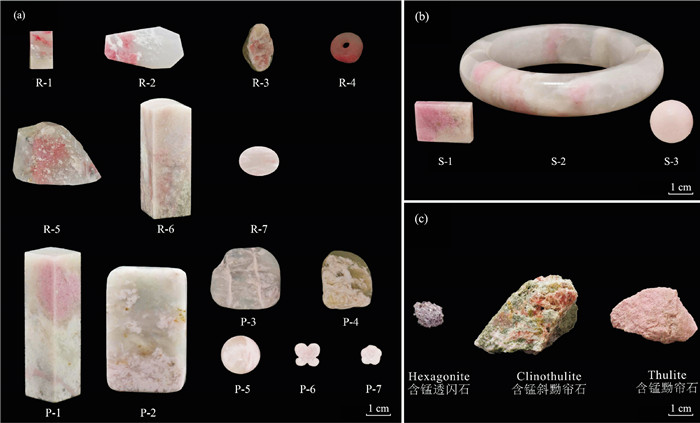
 下载:
下载:
